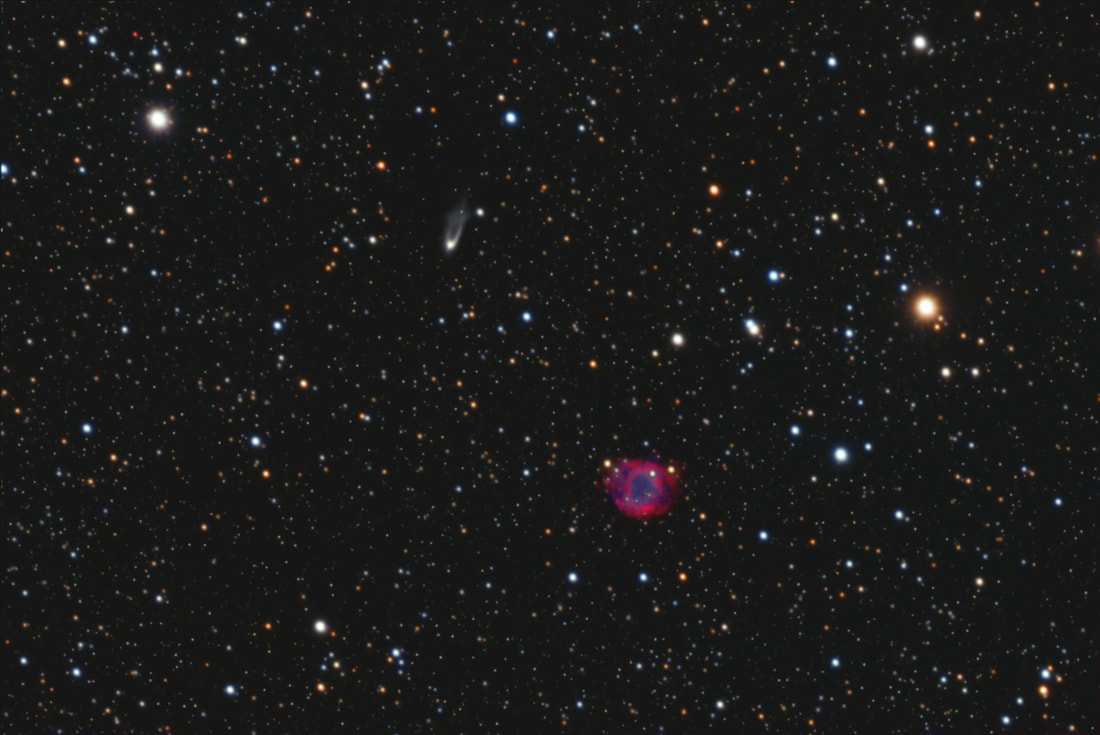Fe 1
The hairpin-like object is known as Parsamian 21. It is one of 23 cometary reflection nebulae discovered by the Armenian astronomer Elma Parsamian in 1965.
It surrounds a young low-mass star which is going through the accretion of circumstellar material. It is one of a unique class of pre-main-sequence stars that have undergone a major outburst in optical light during a temporary, but significant increase of mass accretion rate from the circumstellar disk onto the protostar. These stars are known as FU Orionis objects (FUors).
Parsamian 21 is also surrounded by small dark cloud that obscures stars behind it.
The orb-like object is a faint planetary nebula known as IPHASX J192847.2+093436 which consists of two interlocking shells. Most of the detailed structure is visible in the Ha wavelength, whereas the OIII signal is very faint and diffuse. It was independently discovered by French amateur astronomer Laurent Ferrero and is also known as Fe 1. It is 1 arc minute in diameter.
I believe this is the first true-colour image of Fe 1, and the first time that both objects have been photographed together.
These objects are in the constellation Aquila.
It surrounds a young low-mass star which is going through the accretion of circumstellar material. It is one of a unique class of pre-main-sequence stars that have undergone a major outburst in optical light during a temporary, but significant increase of mass accretion rate from the circumstellar disk onto the protostar. These stars are known as FU Orionis objects (FUors).
Parsamian 21 is also surrounded by small dark cloud that obscures stars behind it.
The orb-like object is a faint planetary nebula known as IPHASX J192847.2+093436 which consists of two interlocking shells. Most of the detailed structure is visible in the Ha wavelength, whereas the OIII signal is very faint and diffuse. It was independently discovered by French amateur astronomer Laurent Ferrero and is also known as Fe 1. It is 1 arc minute in diameter.
I believe this is the first true-colour image of Fe 1, and the first time that both objects have been photographed together.
These objects are in the constellation Aquila.
TARGET
Nomenclature: Parsamian 21, Fe 1, Ferrero 1, IPHASX J192847.1+093439, IPHASX J192847.2+093436
Right Ascension: 19:28:47.34
Declination: +09:34:38.1
Size: 68.2 arc sec (Fe 1)
Discovery: IPHAS survey, Laurent Ferrero (in 2012) and Elma Parsamian (in 1965)
EQUIPMENT USED
Twin APM TMB LZOS 152 refractors
10Micron GM2000 HPS mount
Twin QSI6120 CCD cameras
Astrodon filters
Nomenclature: Parsamian 21, Fe 1, Ferrero 1, IPHASX J192847.1+093439, IPHASX J192847.2+093436
Right Ascension: 19:28:47.34
Declination: +09:34:38.1
Size: 68.2 arc sec (Fe 1)
Discovery: IPHAS survey, Laurent Ferrero (in 2012) and Elma Parsamian (in 1965)
EQUIPMENT USED
Twin APM TMB LZOS 152 refractors
10Micron GM2000 HPS mount
Twin QSI6120 CCD cameras
Astrodon filters
IMAGE CAPTURE
Blue: 23x300"
Green: 27x300"
Lum: 40x120"
Red: 31x300"
Ha: 90x900" bin 1x1
OIII: 47x900 bin 1x1
Total Integration: 42 hours 20 minutes
Pixel scale: 0.265 arcsec/pixel
Field radius: 0.188 degrees
Capture dates: 8-19 October 2021
Capture location: Fregenal de la Sierra, Spain
Blue: 23x300"
Green: 27x300"
Lum: 40x120"
Red: 31x300"
Ha: 90x900" bin 1x1
OIII: 47x900 bin 1x1
Total Integration: 42 hours 20 minutes
Pixel scale: 0.265 arcsec/pixel
Field radius: 0.188 degrees
Capture dates: 8-19 October 2021
Capture location: Fregenal de la Sierra, Spain
IMAGE PROCESSING
Pre-processing: CCDStack2
Post-processing: Photoshop CS2
Pre-processing: CCDStack2
Post-processing: Photoshop CS2
Ha image
OIII image


